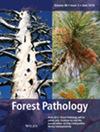Asexual Morph and Molecular Phylogeny of Erysiphe sambuci on Sambucus Hosts in China
Abstract
Although Erysiphe sambuci has been documented in Pakistan and China since 1960, detailed asexual characteristics and molecular phylogenetic analyses are still lacking at present. Preliminary morphological identification of Erysiphe species infecting newly collected Chinese Sambucus javanica specimens in this study is in well accord with E. sambuci var. sambuci. Morphological re-examination of the holotype specimen of E. sambuci var. crassitunicatae suggests the chain-like swellings in chasmothecial appendages are not universally present, and the thickened ascus walls are statistically insignificant (1.65–5.2 vs. 1.9–4.5 μm, p = 0.8029) compared with that of E. sambuci var. sambuci found on S. javanica in this study. Molecular analyses of these two varieties demonstrate that there are only three nucleotide variations in the ITS regions and complete identity in 28S sequences. Phylogenetic reconstruction places both taxa within a single clade with 100% bootstrap support, rejecting infraspecific differentiation. Given the integrated morphological and phylogenetic evidence, we propose to formally reduce var. crassitunicatae to synonymy with E. sambuci. Powdery mildew species with mycelioid chasmothecial appendages found on S. javanica and S. adnata in China should be assigned to E. sambuci without any separation into varieties.

 求助内容:
求助内容: 应助结果提醒方式:
应助结果提醒方式:


